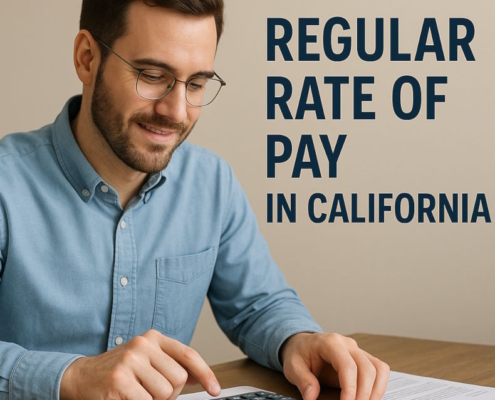California Break Laws
Under California law, non-exempt workers are entitled to two paid 10-minute rest breaks and one unpaid meal break during their eight-hour shift. A California meal and rest breaks attorney can help you recover money owed for not getting meal and rest breaks.
By Brad Nakase, Attorney
Email | Call (888) 600-8654
Get Smarter: Search my blogs
What are the meal break laws in California?
In California, employees have the right to meal breaks under state law. The meal break laws in California are as follows:
- Meal break duration: Employees who work for more than five hours in a day are entitled to a meal break of at least 30 minutes. This break must be uninterrupted, meaning the employee should be relieved of all work-related duties and should be free to leave the premises.
- Timing of meal breaks: The meal break must be provided no later than the end of the employee’s fifth hour of work. If the total work period is no more than six hours, the meal break can be waived by mutual consent of both the employer and the employee.
- Second meal break: Employees who work more than 10 hours in a day are entitled to a second meal break of at least 30 minutes. This second meal break should also be uninterrupted and provided no later than the end of the employee’s 10th hour of work period however, if the total work period is no more than 12 hours, the second meal break can be waived by mutual consent of both parties.
- Waivers: Meal breaks can only be waived if the total work period is no more than six hours for the first meal break or 12 hours for the second meal break. The employee must voluntarily agree to waive the meal break, and this agreement should be in writing.
- Penalties for violations: If an employer fails to provide a meal break as required, they may be required to pay the employee an additional hour of pay at the regular rate for each work day that the meal break is not provided.
It is important to note that there are exceptions and additional rules for certain industries and occupations, such as healthcare workers, on-duty meal periods, and certain exceptions for certain types of employees. It is advisable to consult the California Labor Code or speak an employment attorney in California for specific situations or further clarification on meal break laws.
What are the rest break laws in California?
In addition to meal breaks, California law also provides for rest breaks for employees. The rest break laws in California are as follows:
- Rest break duration: Employees are entitled to a paid rest break of at least 10 minutes for every 4 hours of work or a significant fraction thereof’. This is typically considered to be any amount of time greater than 2 hours. Rest breaks should be provided as close to the middle of the shift as possible.
- Rest break timing: Rest breaks should be given in the middle of each work period, as far as practical. They should not be combined or added to meal breaks. If an employee’s total work period is 3 1/2 hours or less, a rest break may be waived.
- Compensation for rest breaks: Rest breaks are considered paid breaks, which means employees must be compensated for the time spent on their rest breaks.
- Penalties for violations: If an employer fails to provide a rest break as required, they may be required to pay the employee an additional hour of pay at the regular rate for each work day that the rest break is not provided.
As is the case with meal breaks, there may be exceptions and additional rules for certain industries and occupations. It is advisable to consult the California Labor Code or seek legal advice for specific circumstances or further clarification on rest break laws.
What are examples of employers violating meal break laws?
Examples of employers violating meal break laws in California can include:
- Denying meal breaks: Employers who consistently deny or discourage employees from taking their required meal breaks violate the law. This can include situations where employers pressure employees to work through their meal breaks or fail to relieve them of their duties during the designated break time
- Interrupted meal breaks: If an employee’s meal break is interrupted by work-related duties, such as answering calls, attending meetings, or performing tasks, it is considered a violation of the meal break laws. The meal break should be uninterrupted and free from any job-related responsibilities.
- Late or missed meal breaks: Employers who fail to provide meal breaks within the required time frame can be in violation of the law. For example, if an employee works for more than five hours without receiving a meal break or if a meal break is provided after the fifth hour of work, it would be considered a violation.
- Improper waivers: Employers may coerce or pressure employees into signing waivers to waive their meal breaks even when the conditions for waiver are not met. This can occur when the total work period is longer than six hours or 12 hours, depending on the second meal break.
- Inadequate compensation: employers may fail to provide the additional hour of pay to employees when they are not provided with their required meal breaks. If an employer violates the meal break laws, they may be required to pay an additional hour of wages to the employee for each work day that the meal break was not provided.
What are examples of employers violating rest break laws?
Examples of employers violating rest break laws in California can include:
- Denying rest breaks: Employers who consistently deny or discourage employees from taking their required rest breaks violate the law. This can involve situations where employers pressure employees to continue working without taking their rest breaks or fail to provide opportunities for employees to take their rest breaks.
- Inadequate rest break duration: Employers who do not provide the full 10-minute rest breaks required by law violate the rest break laws. If an employer cuts short the rest of break time or only provides a fraction of the required duration, it is considered a violation.
- Timing issues: Employers who fail to provide rest breaks in the middle of the work period or as close to the middle as possible violate the law. Rest breaks should be scheduled in a way that allows employees to take a break from work duties after a reasonable period of continuous work.
- Combining rest breaks with meal breaks: Employers who combine or add rest breaks to meal breaks violate the law. Rest breaks and meal breaks are separate entities and should be provided as distinct periods of rest.
- Discouraging or retaliating against employees: Employers who discourage employees from taking rest breaks or retaliate against employees who assert their rights to rest breaks violate the law. For example, if an employer penalizes or discriminates against employees who take their entitled rest breaks, it is considered a violation.
What is the importance of meal and rest breaks?
Violating meal and rest break laws is detrimental to employees for several reasons. First, rest breaks are essential for employees to rest, recharge, and maintain their physical and mental wellbeing. Denying or interrupting rest breaks can lead to increased stress, fatigue, and reduced productivity.
Also, continuous work without adequate rest breaks can increase the risk of accidents and injuries due to fatigue-related errors or diminished concentration. Rest breaks provide employees with the necessary time to recover and maintain their alertness and focus.
Employers who violate rest break laws can face legal consequences, including penalties and potential legal action from employees, according to a California employer attorney. This can result in financial liabilities, damage to the employer’s reputation, and potential legal sanctions.
Providing employees with their entitled rest breaks demonstrates respect for their well-being and helps foster a positive work environment. Violating rest break laws can negatively impact employee morale, job satisfaction, and overall employee relations.
It is important for employers to comply with rest break laws to ensure the health, safety, and well-being of their employees and to avoid legal and reputational risks. Employees who believe their rights have been violated should consider seeking legal advice or filing a complaint with the appropriate labor authorities.
What to do if denied meal or rest breaks?
If an employee believes their employer is denying them meal or rest breaks or otherwise violating employment laws, they can take the following steps:
- Document the violations: Keep a detailed record of the instances where meal or rest breaks were denied or interrupted, noting dates, times, and any relevant details. Documentation will provide evidence to support the employee’s claims.
- Know one’s rights: Familiarize yourself with the applicable labor laws, including the specific meal and rest break requirements in your jurisdiction period understanding your rights will help you determine if a violation has occurred.
- Communicate with the employer: In many cases, the issue may be resolved through open communication. Discuss the concerns with the employer or supervisor, respectfully expressing the belief that your rights to meal and rest breaks are being violated. Provide examples and refer to the relevant labor laws.
- Consult with colleagues or union representatives: Speak to coworkers or union representatives, if applicable, to see if others are experiencing similar issues. Collective action or support can be effective in addressing violations and seeking a resolution.
- File a complaint: If the employer does not address the issue or if the violations continue, the employee can file a complaint with the appropriate labor authority. In California, employees can file a complaint with the California Labor Commissioner’s Office or consult with an employment attorney to explore legal options.
- Retaliation protection: It is important to note that retaliation for asserting your rights is illegal. If an employer retaliates against an employee for reporting violations or filing a complaint, additional legal protections may be available.
- Seek legal advice: If the violations persist or if the situation becomes complex, it is advisable to consult with an employment attorney. They can provide guidance, evaluate the merits of the case, and help protect your rights.
Have a quick question? We answered nearly 2000 FAQs.
See all blogs: Business | Corporate | Employment Law
Most recent blogs:
Contact our attorney.
































